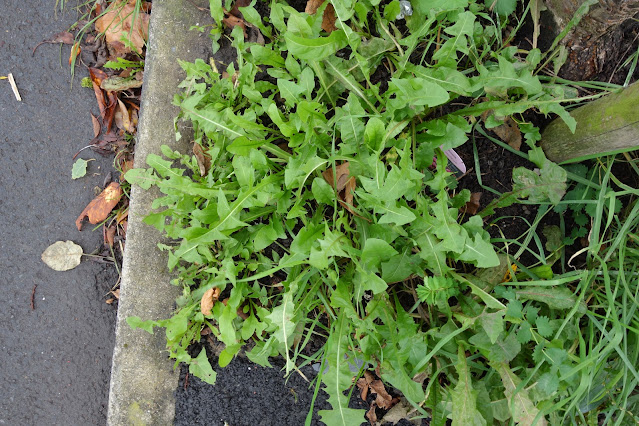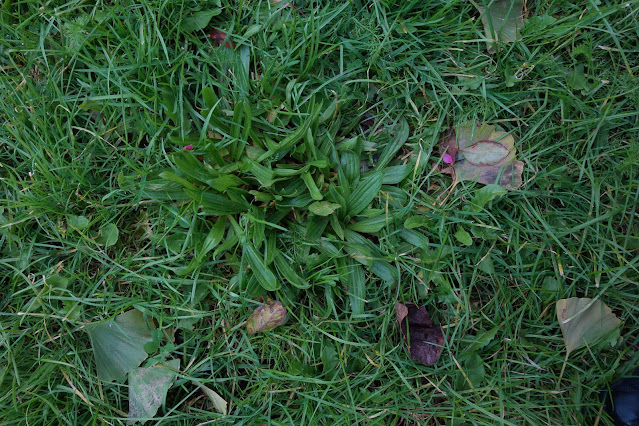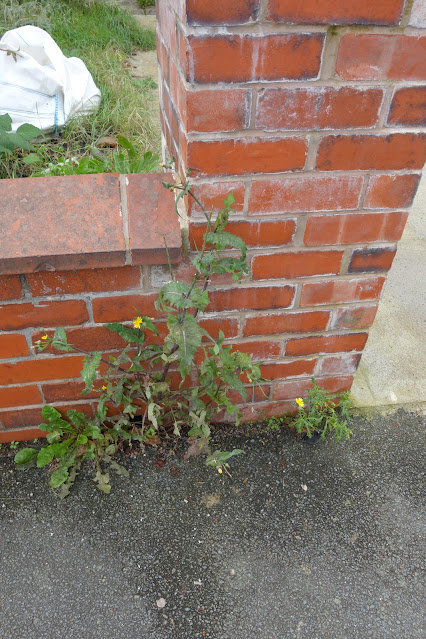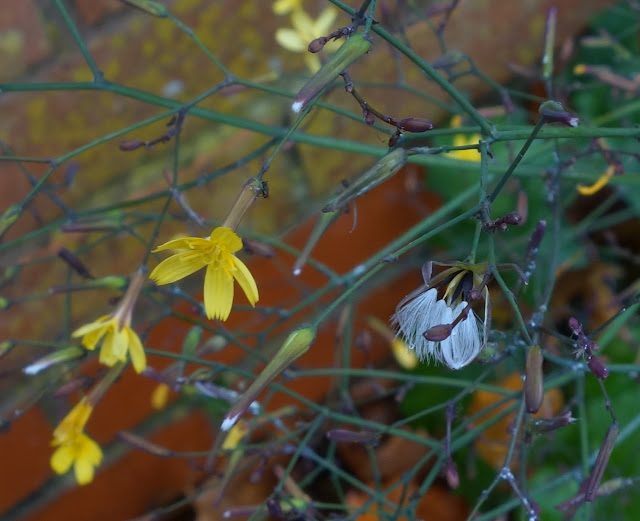I have been doing a very interesting free foraging course run by Lad from the Boiler House. This is my homework. All of these photos were taken on 19/10/23, except the chicory flower.
I thought I would go on a 15 minute walk from home and see how many edible plants grew by the pavement. At least, they would be edible if we had not used lead in petrol for so many decades and paved our roads and pavements with asphalt.
UPDATE (1/8/2024): The Natural History Museum has just published a guide called
Pavement Plants: A guide to plants frequently growing on pavements in the UK. As well as paying for a physical copy, it is available
for free to download at this link.
The first plant I saw was a garden escape, an exotic Adria bellflower with the ridiculous botanical name of Campanula portenschlagiana. Many of the Campanula species have edible leaves, though some are more chewy than others. Some have edible tuberous roots. Native species include bellflowers, harebells and rampion.
Many of the knotweed species are edible including the notorious Japanese knotweed. The ones I found today are much smaller and less problematic.

Some knotweeds are tiny.
The common sow thistle is a very common weed that has a long history of being used as a vegetable. There is an ancient Greek myth about Theseus, most famous for killing the man-bull Minotaur. On his way to his less famous bull-related pest control job of capturing and killing the Bull of Marathon, he was given hospitality by a poor old woman called Hecale. She fed him a dish of sow-thistles. On his return, Theseus found that Hecale had died. Theseus later instituted sacrifices at Athens to the memory of Hecale.
The prickly sow thistle is a closely-related plant that has more prickles and less leaf. Not so nice as a vegetable.
The wall lettuce is another wild relative of common vegetables that is too bitter to enjoy as a salad.

The leaves of wall lettuce have a similar pattern to the sow thistle but are darker and much more shiny.

Everybody knows the dandelion, of course. Every part is edible but
the leaves are notorious for increasing the body's output of urine. This
is the reason it was called piss-a-bed in English and the same meaning
as pissenlit in French. They are bitter but the medicinal effect
and the bitterness can be reduced by blanching - putting a dark cover
over the plant until the leaves become white.


If
you have seen chicory in supermarkets you will have seen a pale compacted mass of
leaves that have been blanched by being kept in the dark. Below is a
picture of the wild plant as it was on 19/10/23 and how the flowers
looked earlier in the year on 11/8/23. The wild chicory is also edible
but very bitter.

All of the other members of this plant family on this page have yellow flowers. They do come in many different colours - orange, red, purple, blue, green and violet. There is an abbreviation used by botanists - DYC. Damn yellow composites, because there are so many yellow-flowered members of this family that are difficult to tell apart, even for botanists.

Nipplewort
is another member of the daisy, dandelion, chicory and lettuce family.
It is also edible but a little furry and bitter. It was used to treat
nipples damaged by breast-feeding, which gave it its name.


The plant below is a hawksbeard. It has obvious resemblances to the lettuce, dandelion, sow-thistle, chicory and nipplewort. All have tiny flowers gathered together in something that looks like a single large flower. All have fluff on the seeds to help them fly.The hawksbeards are another group that have edible leaves, though they might be bitter and in this case, slightly furry.
The leaves are easy to confuse with dandelions. This is why it is important to check the flowers for many plants, to be sure you have the right plant.
The following pictures are of the shepherd's purse, a small relative of cabbage and mustard. It is easy to identify because of the heart-shaped seed capsules.
Though often eaten by foragers it may be dangerous if it is grown on soil with heavy metals, including lead. The shepherd's purse accumulates lead from the soil and deposits it in its leaves. There appears to be
another toxicity suggested by Plants for a Future, though I don't know about that yet, I only just saw it. I must research that.
Though usually tiny, given some space and food, the shepherd's purse can become larger and more abundant.
Another common plant on the streets is chickweed. This used to be a common ingredient in spring salads taken as a tonic to improve the health of those who had suffered through a winter without fresh vegetables.
The spectacular invasive evening primrose from North America is quite common on Manchester roads. The leaves and tuberous root are edible, if you can find it in a less toxic environment. The flowers have a lovely mild fragrance.
The plant grows over two years, in the first year it produces a flat rosette of leaves. The next year it uses the stored food in its fat roots to produce the flowers and seeds. Though the tubers are edible, it is very important to be sure which plant you are digging up. There are many poisonous tubers among our plants and often very little above ground to identify them when they are at their fattest.
Plantains are a common weed that comes with a range of leaf shapes. All
have edible leaves and are used for medicine. The name is spelt the same
as the type of banana used for cooking but they are not related in any way.

Everyone knows the nettle, a lovely green vegetable when young. Best cut before it flowers. Makes a lovely soup boiled with potatoes and then liquidised.
Pellitory of the Wall is a relative of nettles that is small, cute and furry - it does not sting. The leaves can be eaten raw or cooked.

The pretty little flowers below are the ivy-leaved toadflax. These are edible raw or cooked. It grows on walls very commonly and I have it on my garden walls. My photos from 8 years ago are better than these, annoyingly. I have commented on the taste and possible toxicity to livestock on that old article.
Below are the very distinctive fragrant leaves of yarrow. I did not see any flowers on my walk though they flower through most of the year. The leaves were a famous medicine for wounds throughout the centuries before modern medicine. Not a good idea to use them when growing so low on pavements and verges, unless you can wash it thoroughly.
Many of the wall weeds are toxic or inedible. It is, of course, as important to identify the poisonous plants as it is to know the edible ones. The black nightshade is poisonous though the same species has been selected by gardeners to produce edible fruit, known in the US as the huckleberry. It is related to potatoes, tomatoes and chili peppers, all of which have some parts that are toxic.



There are a lot of spurges to be found as weeds in our streets. Some are native and some are exotic garden escapes. All are toxic and many will burn the skin if the milky juice is left on the skin.



The beautiful Welsh poppy is native not only to Wales but to northwest England. I have seen the true native around Alderley Edge. It is difficult to know whether the plants in towns are native or escaped from gardens. Though if it is dark orange it is likely to be a garden escape. The 17th century herbalist Parkinson knew of no medicinal uses for this plant and called it the "Yellow wild Bastard Poppy of Wales". It is likely to be poisonous.
I found quite a few more interesting plants but the wind was strong and I could not get good photos of those.





























































